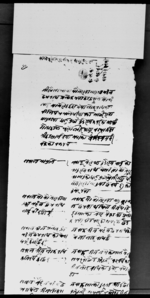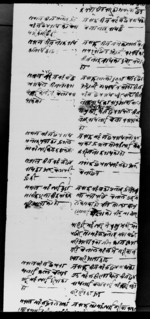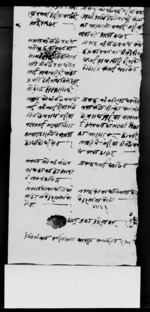A bakapatra supplied by Udairāma Kavara re Mahanta Chetranātha's abbatial succession in Rānagāũ (VS 1964)
ID: K_0469_0039
Edited and
translated by Christof Zotter
Created: 2018-09-19;
Last modified: 2018-12-04
For the metadata of the document, click here
The accompanying edition, translation/synopsis and/or commentary are available under the terms of the Creative Commons Attribution-ShareAlike 4.0 International License
Abstract
In this statement, made in front of Lieutenant Colonel Vīra Bahādūra Basnyāt Kṣetrī of the Salyan district office (gauḍā), Ghāṭu Buḍhā Udairāma Kavara answers questions regarding the abbotship of Mahanta Chetranātha in Rānagāũ, Salyan.Diplomatic edition
[1r-part1]
1श्रीलेकर्णेलरणवीक्रम्वहादुरराणा2\⟪140⟫[seal]1दःलेःकः
2वीरवहादूर
3वस्न्यात्क्षत्री¯ 1जील्यैसल्यानामौजेरानागाउकामहंत
2छेत्रनाथप्रलोकभयाकोहुनालेसोमहं
3त्याईमामेरोहकहोभंन्यालोकनाथका•
3वीन्तीपत्रमालेषीयाका•साछीराना
4गाउवस्न्या•घाटुवुढाउदैरामकव़रकोसल्ल्यां
5गौडाकालेकर्णैलवीरवाहादुरवस्न्यातक्षे
6त्रीकासामंनेमाभयाकोधर्मसमझी
7वकेकोवक्पत्र¯¯ ¯¯¯¯¯¯¯
8¯¯¯¯¯¯¯¯¯¯¯¯¯¯¯¯¯¯
[table1-part1]
| 1 | सव़ालमामुलि¯¯¯¯ \ | जवाफ्मेरोनाउउदैराम•वावुको नाउरतिनाथ•पेसासोमौजेरा नागाउकोघाटुवुढारषेतीगर्छु•घर सोहीरानागाउमाछवर्ष६७को उमेरभयो•¯¯¯¯ ¯¯¯¯¯¯ |
| 2 | सव़ालसोमौजेरानगा उकामहंन्तछेत्रनाथ लाईचींन्दछौकी¯ ¯ ¯¯ ¯¯ \ | जवाफसोमौजेरानगाऊकामह न्तछेत्रनाथथियोनीजयेहि ६४साल्काजेष्टमैन्हामाप्रलो कभयादीनवारकोसम्झनाछैन |
| 3 | सवालनीजप्रलोकहुने महंन्तछेत्रनाथकोचेला पनीकोहीछंकी¯ ¯ ¯ \ | जवाफनीजमहंन्तछेत्रनाथको चेलालोकनाथछं¯¯¯¯¯¯¯¯¯ |
| 4 | सवालनीजलोकनाथ कतिवर्षकाछन्¯ ¯¯ \ | जवाफ्नीजजन्मेकोसालमैना सम्झनाछैनअंदाजी१२वर्षका नीजलोकनाथकोउमेरभयो हो¯¯¯¯ ¯¯¯¯¯ |
[1r-part2]
[table1-part2]
| 1 | सव़ाल•नीजमहंन्तछे त्रनाथलेनीजलोकना थलाईकैलेदेषीचेलोवना याकोहो¯¯¯ ¯¯¯ \ | जवाफ्साल्कोदुरुस्त•थाहछैन अदाजी४।५वर्षभय़ोहोनीज महंतछत्रनाथपीरवस्दानीज लोकनाथकावावुआमावाटत्[...] ग•चुकाई⟪[fingerprint]⟫⟪दांचौघेरामा⟫⟪[fingerprint]⟫नीजछत्रनाथलेनीज लोकनाथलाई चेलावनाय़ाको हो¯¯¯¯¯¯¯ ¯¯¯¯¯¯¯ |
| 2 | सव़ाल•महंन्तछेत्रनाथ प्रलोक्भय़ाकोहुनाले• सोमहंत्याइकोहककस्कोहो | जवाफमहंन्तछेत्रनाथपर्लोकभ याकोहुनालेसोमहंत्याइकोह कनीजलोकनाथकोहो¯¯¯ |
| 3 | सव़ालनीजमहंन्तछेत्र नाथकोअरुचेलापनी छंकी¯¯¯¯¯¯¯¯ \ | जवाफछेत्रनाथमहन्तकोअरु चेलाछैन¯¯¯¯¯¯¯¯ |
| 4 | सव़ाल•महंत्याइहुदा सावीकदरसावीकमाकेके गरीआयाकोहो¯¯¯¯ \ | जवाफ्महंन्तकोप्रलोक्हुनेअव स्ताभय़ापछी•चेलालेगुरुमै लेकेगर्न्याहोभनि•सोद्धा•पाषु रासमाईचेलाकोपीठ्माधाप् मारीदीमहंत्याईभैवस्नुभनीभने पछीरसोमहंन्तप्रलोक्भयापछी गरीआयाबमोजीम्काजकृया गरीचेलालेमहंन्तभैगद्दीमा•व स्नागरीआयाकोछ¯¯ ¯¯¯¯ |
| 5 | सव़ालमहंन्तछेत्रना थलाईकस्लेचेलाव नाईमहंत्याईदीय़ाको हो•¯¯¯ ¯¯¯¯¯¯\ | जवाफ्नीजमहंतछेत्रनाथको गुरुमहंन्तहीरानाथलेनीजछेत्र नाथलाईचेलावनाई•महंत्याईपाउने गरी•राषेकाहुन्¯¯¯¯¯¯ |
[1r-part3]
[table1-part3]
| 1 | सव़ालमहंतहुनेले•सकार• मावक्साई•गद्दीमावस्ने गरीआयाकोछकीआफैव सीआयाकोछ¯¯¯ | ज्वाफसोमहंत्याञी•गद्दीमावस्ता अघीदेषी•सल्ल्यांगौडाका•भारा दारसंग•वक्साई•गद्दीमावस्न्या गरीआयाकाछन्¯¯¯¯¯¯¯¯¯¯ |
| 2 | सव़ालमहंतछेत्रनाथ• प्रलोक्हुनावषतमा• सोमठकोका⟪[fingerprint]⟫⟪म्⟫⟪[fingerprint]⟫तिमीलेगर्न भनि•नीजछेत्रनाथलेम लाईअषत्यारीदीय़ाको छभनिदेवीनाथजिलेउजुर गरेकोछसोकुराहोकी ¯\ | जवाफ•महंतछेत्रनाथ•प्रलो क्हुन्यावषतमानीजदेवीना थलाईअषत्यारी•दीयाको• होहोईनमलाईथहाछैन |
| 3 | सव़ालसोमहंन्तछेत्रनाथ लाई•महंन्त्याईदीयापछि निजछेत्रनाथगद्दीमा वस्नालाईसल्ल्यांगौडा काभारादारसंगवक्सा याकोथीय़ोथीये़न¯¯¯ \ | जवाफ्•महंन्तहीरानाथप्रलोक भय़ापछी•निज्कोचेलामहंत छेत्रनाथगद्दीमावस्नाला ईउसवषतकासल्ल्यांगौडा का•भारादार¯ \ ¯कोपनी सव़ारीभै•गद्दीमानीजछेत्रना थवस्याकाहुन¯¯ ¯¯¯¯ |
| 4 | सव़ाल•सोमहंन्तछेत्र नाथकामठकोआंदा नीलगतकतिछ¯¯¯¯¯\ | जवाफमलाईथहाछैन |
[1r-part4]
[table1-part4]
| 1 | सव़ाल•य़ोमाथीलेषी य़ाकोसवैदुरुस्तसाचोहोकी¯¯¯¯¯¯\ | जवाफ•योमाथीलेषायाकोस वैदुरुस्तसाचोहो \ \ • \ \ |
9घाटूवुढाउदैरामकव़र¯¯¯ \१
10ईतिसंम्वत१९६४सालश्रावण१०गतेरोज५शुभ्म्¯¯1 [fingerprint] 1दःले•कः
2सही
Translation
[1r-part1]
Venerable L[ieutenant] Colonel Raṇavīkram Bahādura Rāṇā
401
[seal]
[signature of] Da.2 L[ieutenant] C[olonel] Vīra Bahādūra Basynāt Kṣatrī - - -
Testimony (bakapatra) given, keeping the dharma in mind, in front of L[ieutenant] Colonel Vīra Bahādura Basynāta Kṣetrī of the Salyan district office (gauḍā) by Ghāṭu Buḍhā Udairāma Kavara, a resident of Rānāgāũ [and] witness mentioned (lekhīyākā) in the petition (bintīpatra) from Lokanātha which states: "inasmuch as Chetranātha, the abbot (mahanta) of Rānāgāũ maujā , Salyan district (jillā), has passed away, the right to the abbotship is [now] mine."3
[table]
| Question: general [introduction] | Answer: My name [is] Udairāma; [my] father's name [is] Ratinātha. Profession: I [am known as] the ghāṭu buḍhā4 of Rānāgāũ maujā and I do fieldwork. [My] home is in the same, [namely] Rānāgāũ. [My] age is 67 years. | |
| Question: You knew Mahanta Chetranātha of Rānāgāũ maujā, or not? | Answer: The mahanta of Rānāgāũ maujā was Chetranātha. The said [Chetranātha] passed away in the month of Jyeṣṭha this year, [VS 19]64. The day [and] weekday I do not remember.5 | |
| Question: Was there also some disciple of the said late Mahanta Chetranātha, or not? | Answer: There was a disciple of the said Mahanta Chetranātha: Lokanātha. | |
| Question: How old is the said Lokanātha? | Answer: The year [and] month of birth of the said [person] I do not remember. The age of the said Lokanātha is approximately 12 years. |
[1r-part2]
[table]
| Question: When did the said Mahanta Chetranātha make the said Lokanātha [his] disciple? | Answer: The year I do not know exactly. It was approximately 4 or 5 years ago.6 When the said Mahanta Chetranātha was residing as head of the monastery (pīra) [and] the said Lokanātha had already left [his] father [and] mother, the said Chetranātha made the said Lokanātha [his] disciple in DangCaugherā.7 | |
| Question: Now that Mahanta Chetranātha has passed away, who has the right to the abbotship? | Answer: Now that Mahanta Chetranātha has passed away, the right to the abbotship is the said Lokanātha's. | |
| Question: There are other disciples of the said Mahanta Chetranātha, or not? | Answer: There are no other disciples of Chetranātha, the mahanta. | |
| Question: What all is traditionally done in the customary practice when one accedes to the abbotship (mahantyāñī hundā)? | Answer: When the mahanta is about to die, the disciple asks: "Guru, what shall I do?" [The mahanta] seizes [the disciple's] upper arm, slaps the disciple's back [and] afterwards says: "Accede to the abbotship [and] occupy [the throne]." And after the mahanta passes away, the disciple performs the kājakṛyā8 according to what is traditionally practised, becomes mahanta [and] occupies the throne. [This is what] is traditionally done. | |
| Question: Who made Mahanta Chetranātha [his] disciple [and] gave [him] the abbotship? | Answer: The guru of the said Mahanta Chetranātha, Mahanta Hīrānātha, made the said Mahanta Chetranātha [his] disciple and appointed him [his successor] so that he would receive the abbotship. |
[1r-part3]
[table]
| Question: Is it the tradition that a mahanta-to-be occupies the throne [only] after being authorized by the government, or is it rather the tradition that he occupies [it] on his own? | Answer: Once the [one who is selected for] the abbotship [is set to] occupy the throne, it is the tradition from earlier times to do so [only] after being authorized by the bhārādāra of the Salyan district office. | |
| Question: Devīnāthajī has submitted a complaint, saying "When Mahanta Chetranātha was passing away, the said Chetranātha gave me the authority, saying, 'You do the work of [overseeing] the maṭha'." It is so, or not? | Answer: I do not know whether or not authority was given to the said Devīnātha when Mahanta Chetranātha was passing away. | |
| Question: After Chetranātha was given the abbotship (by his guru), was the said Chetranātha authorized to occupy the throne by the bhārādāra of the Salyan district office, or not? | Answer: After Mahanta Hīrānātha passed away, in order for his (nījako) disciple Chetranātha to [be able to] occupy the throne, the then bhārādāra of the Salyan district office, [venerable L[ieutenant] Colonel Raṇavīkraṃ Bahādūra Rāṇā], 9 came (savārī bhai) [and] the said Chetranātha occupied the throne. | |
| Question: How much was Mahanta Chetranātha's assessment of the maṭha's the revenue? | Answer: I do not know. |
[1r-part4]
[table]
| Question: Is all that is written above the exact truth, or not? | Answer: All that is written above is the exact truth. |
[fingerprint]
Ghāṭu Buḍhā Udairāma Kavara - - -
signature Da.10 L[ieutenant] C[olonel]
Thursday, the 10th solar day (gate) of Śrāvaṇa in the [Vikrama] era year 1964 (1907 CE). Auspiciousness.
Commentary
For more information about the background to such witness statements and related documents, see the Commentaries to K_0469_0033 and K_0469_0038.




